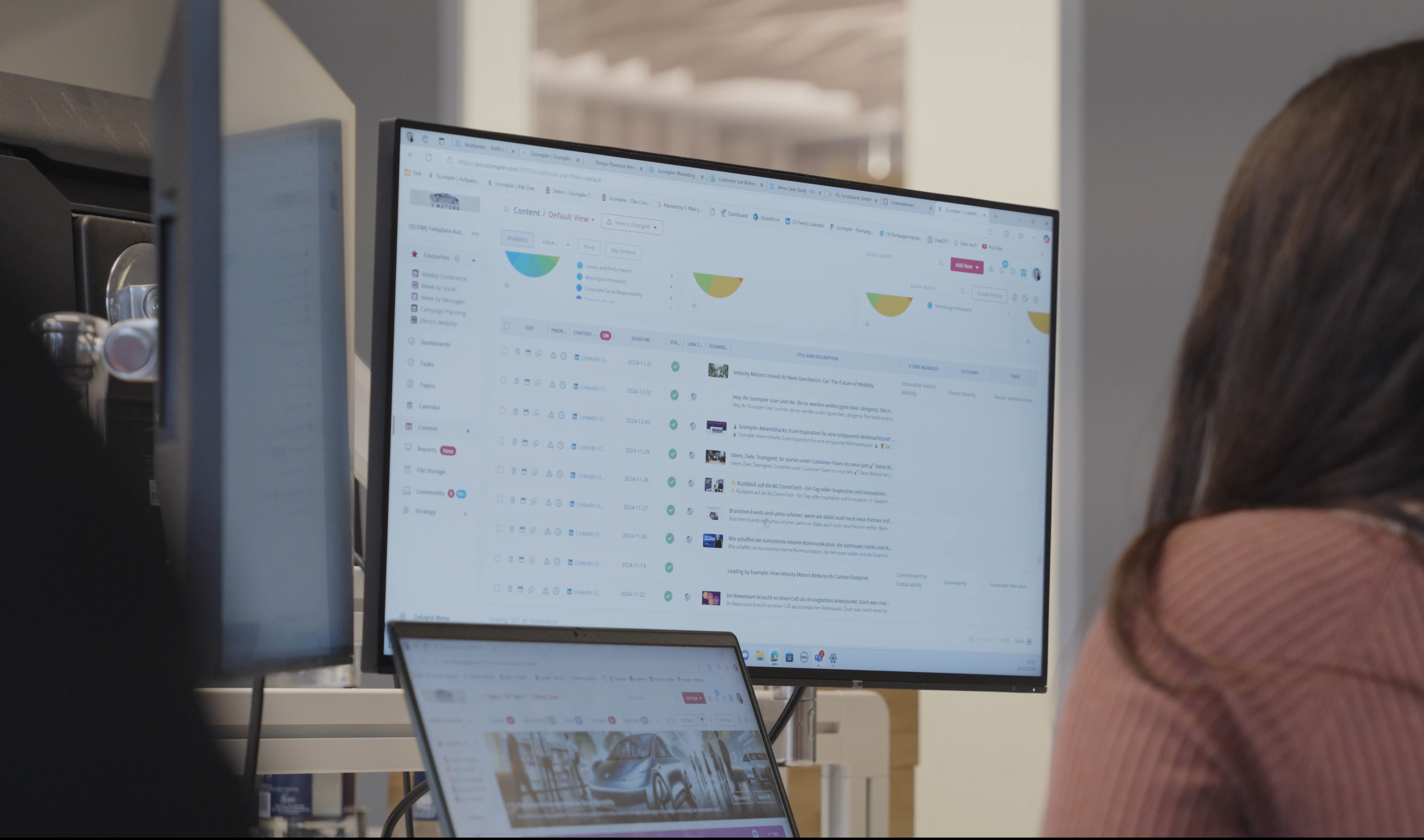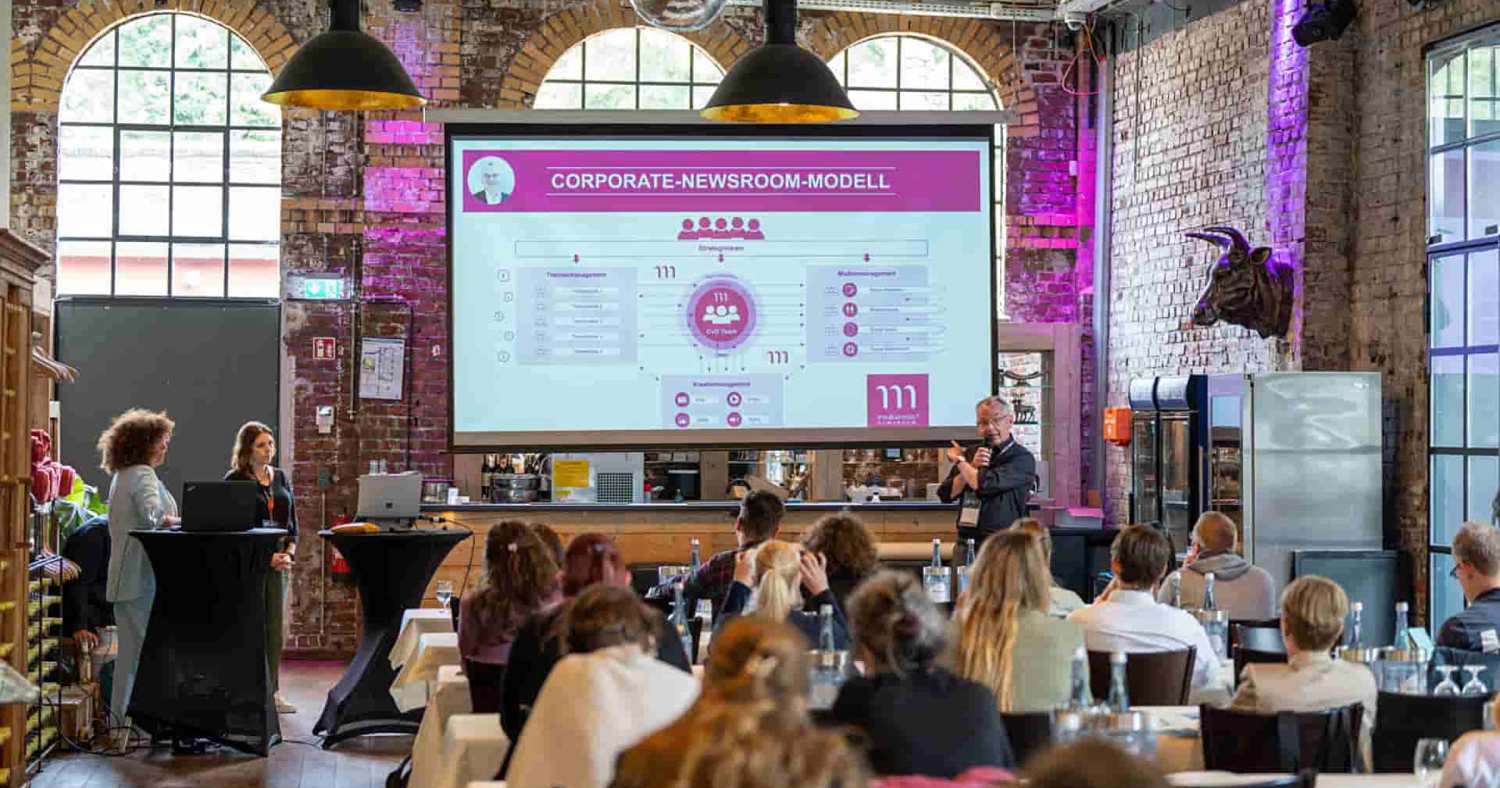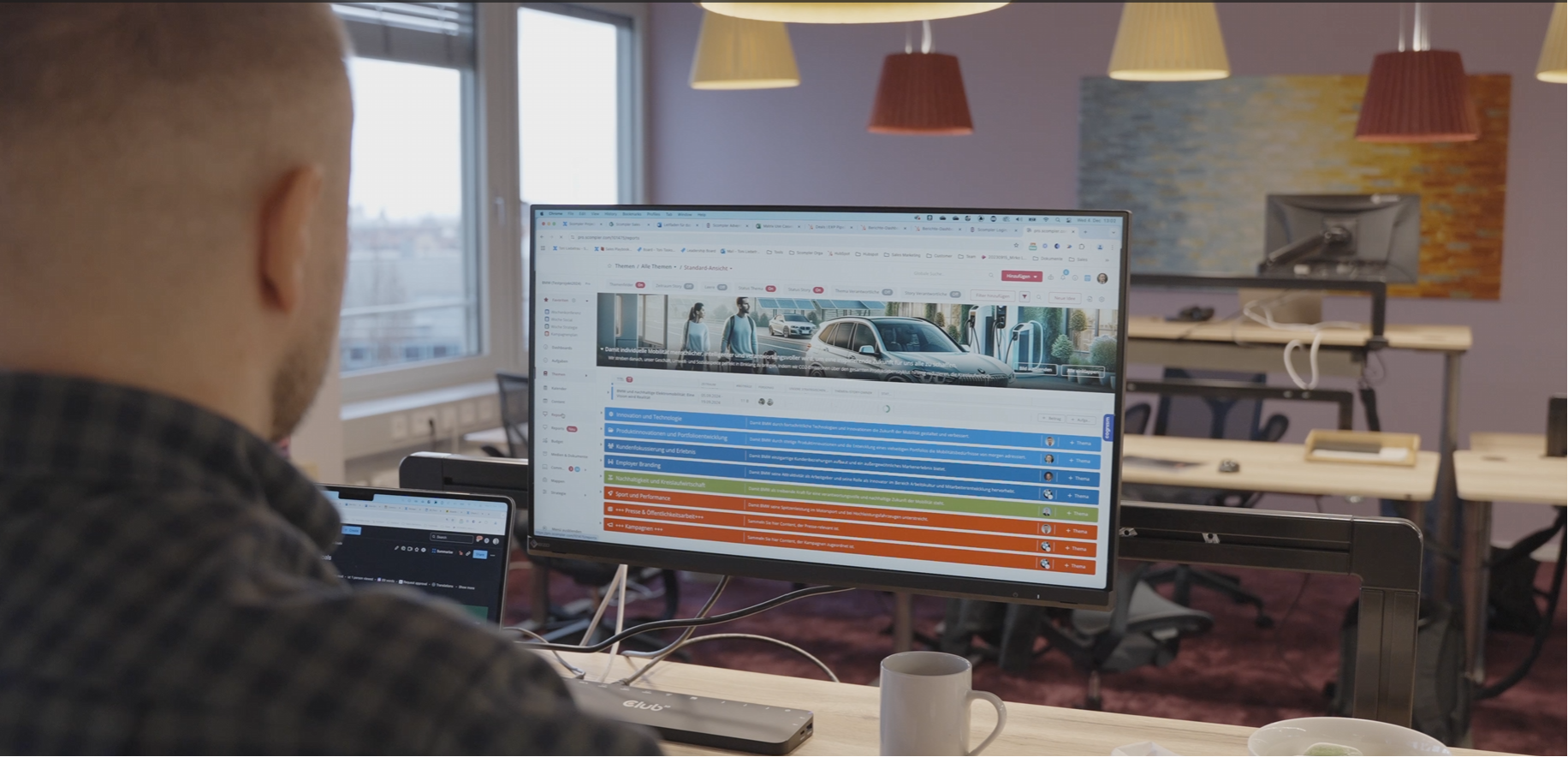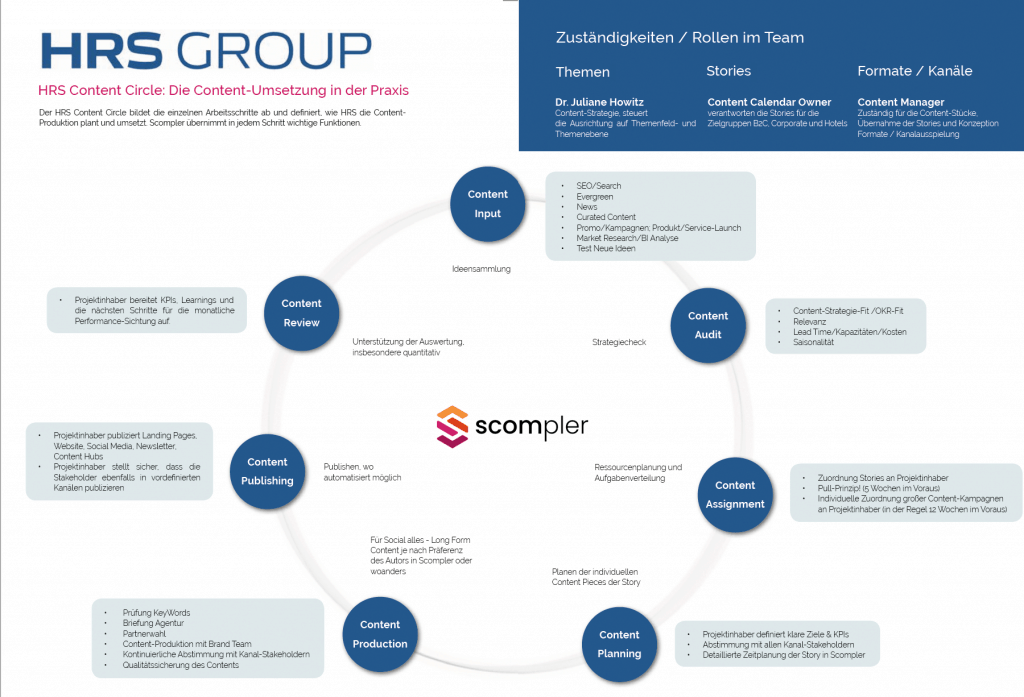Content Marketing bei HRS: Sichtbarkeit, Transparenz, Transformation
Wie Scompler HRS hilft, die internen Kommunikationsstrukturen zu transformieren und die Kundenansprache strategisch und themenorientiert auszurichten

Wer auf einer Reise eine Übernachtungsmöglichkeit sucht, bucht früher oder später über HRS. Ein Team in der Kölner Zentrale der HRS Group steuert und erstellt in einer Schlüsselrolle die Inhalte für die Kommunikation und setzt dafür Scompler ein.
Juliane Howitz, Team Lead Content Marketing von HRS, spricht über die ersten Schritte von HRS im Bereich Content Marketing und die dadurch entstandene zentrale Funktion ihrer Abteilung. Und sie erzählt, wie Scompler dazu beigetragen hat, ein tiefes Gefühl der Verbundenheit und des Vertrauens im Team zu erzeugen.
Juliane Howitz muss mit ihrem Team komplexe Anforderungen erfüllen, die auf die Kommunikation mit Geschäftsreisenden, Travel Managern und Hotelpartnern abzielen. Es geht also nicht nur um B2C-Content: Seinen Umsatz generiert das 1972 gegründete Kölner Familienunternehmen inzwischen überwiegend im internationalen B2B-Travelmanagement.
Nach wie vor erwirtschaftet HRS aber auch einen nicht unerheblichen Teil seines Umsatzes im B2C-Bereich. Dabei entsteht ein stattliches Content-Volumen: HRS erstellte 2018 allein für dieses Segment 3.830 Content-Stücke.
Die Ausrichtung auf das Content Marketing führt zu einer Transformation: #ByeByeExcel‘
Die aktuelle Art und Weise zu kommunizieren, basiert auf einer Neuausrichtung der Kommunikation im Juli 2015 auf einen zentralen Content-Marketing-Ansatz. Damals wurden die Kanalteams mit dem Ziel aufgelöst, Inhalte ins Zentrum der Planung zu stellen und sich erst im Anschluss Gedanken über die Ausspielkanäle zu machen. Juliane Howitz hat diese Umstrukturierung von Anfang an mitgestaltet. Schnell wurde klar, dass eine solche Umstellung der Kommunikation nicht von einem Tool wie Excel begleitet werden konnte.
Seit dem 1. Januar 2016 ist deshalb Scompler als Redaktionsplattform im Einsatz, die eine strategische Kommunikationsplanung über Themenfeldern, Themen, Stories und Einzelbeiträge unterstützt. Damals begann eine Transformation, die bis heute anhält, und die nicht immer leichtfiel. „Die Umstellung hat zu Wachstumsschmerzen im Team geführt. Denn alle Kollegen kamen aus den individuellen Kanalteams, die sich eigentlich nicht dafür beworben haben, Content Marketing zu machen. Es gab Meetings mit Widerstand gegen die Veränderungen, nicht alle Kollegen waren begeistert. Interessanterweise sind viele dieser Kollegen heute noch hier, und jetzt sind alle happy und finden es total sinnvoll, dass wir nicht mehr kanalspezifisch arbeiten.“
Die Verantwortlichkeiten sind auf Rollen aufgeteilt, die sich auch in Scompler wiederfinden. Juliane Howitz ist für die Content-Strategie zuständig und steuert die Ausrichtung auf Themenfeld- und Themenebene. So genannte Content Calendar Owner (in der Funktion von Redaktionsleitern) verantworten die Stories für die drei Zielgruppen B2C (Geschäftsreisende), B2B (Firmenkunden) und Hotels. Die Content Manager sind für die einzelnen Content-Stücke zuständig – sie übernehmen also die Stories und überlegen, wie diese Kampagnen konkret auf den Kanälen in den verschiedenen Formaten ausgespielt werden.
Verändertes Mindset: Mut zur Content-Lücke
Verändert hat sich auch das Mindset, wie Content ausgespielt wird und welche Zielsetzungen die Inhalte erfüllen müssen. Die themenzentrierte Content-Planung half Publikationslücken im Kalender aufzudecken – die bei manchen Teams allerdings den Impuls triggerten, diese Lücken mit irgendeinem Inhalt zu füllen. Hier wird inzwischen sehr stringent hinterfragt, ob der Content auch auf strategische Ziele einzahlt.
Dass Juliane Howitz inzwischen einen Teil des Content Marketing Teams führt, hat sich aus ihrer Affinität zur Strategie ergeben und ihrem Verständnis von Zusammenarbeit. Noch als Content Managerin hat sie die Content Strategie neben ihren operativen Tätigkeiten „mitgemacht“, bis erkannt wurde, dass man die Strategie nicht einfach so nebenbei entwickeln kann und dafür eine eigene Stelle notwendig ist.
„Ich habe wohl als eine der Ersten bei uns verstanden, dass Kanalmarketing nicht die Zukunft ist. Es ist absurd, sich auf Kanalbasis tot zu optimieren, solange wir nicht anfangen, miteinander zu sprechen und wirklich zusammenzuarbeiten. Die Ausrichtung hat sich also verändert, und sie ist alternativlos: Wir müssen Inhalte kanalübergreifend erstellen mit der Story als zentralem Element.“
HRS: Content in Zahlen
Kanäle und mehr Ausspielungsorte von Content
Zeitzonen. Teams in Köln, London, Dallas
Content-Stücke in der Content-Produktion für B2C in 2018
und mehr Content-Stücke pro Monat in 2019
Ein übergreifendes gemeinsames Verständnis im Team ist einer der wichtigsten Faktoren für eine gelingende Unternehmenskommunikation. Eine Hauptaufgabe ist deshalb auch heute noch die Vermittlungsfunktion: Juliane Howitz bricht das Strategische runter und erklärt dem Team die Bedeutung für die operative Umsetzung.
Juliane Howitz: „Die Leute müssen nach einem Strategiemeeting wissen, was die Strategievorgaben konkret für ihre Arbeit bedeuten. Diese Übersetzung von Strategie ins Operative ist sehr schön darzustellen mit einem Tool wie Scompler – und das ist aus meiner Sicht der Knackpunkt, ob Content Marketing funktioniert oder nicht, und ebenso dafür, dass sich bestehende Widerstände aufgelöst haben.“
Seit die drei Marketingteams und deren Zuständigkeiten für die Business Units B2C, B2B und Hotelpartner in einem Team zusammengeführt wurden, nimmt das Content Marketing Team eine zentrale Rolle in der Unternehmenskommunikation ein. Ausschlaggebend dafür war die Expertise des Content Marketing Teams, die es sich aus der kanalübergreifenden Arbeit bereits angeeignet hatte: die Qualität der Kommunikation sehr hoch zu halten und Informationen über alle Kanäle hinweg konsistent auszuspielen.
Es ist ein Erfolgsrezept, Business-Ziele und Kundenbedürfnisse zusammenzubringen und daraus die Kommunikation zu entwickeln. Es ist alternativlos, sich zusammenzusetzen und kanalübergreifend in die Zukunft zu blicken.
Dr. Juliane Howitz, Team Lead Content Marketing
Inzwischen laufen 70% des gesamten Contents bei HRS über den Schreibtisch des Content Marketing Teams. Durch die intensive Beschäftigung mit strategisch ausgerichtetem Content Marketing und den besonderen Anforderungen dieser Disziplin, wurde das Team intern als Vorreiter für neue Arbeitsweisen wahrgenommen.
„Als Content Marketing Team wurden wir inhouse auch immer mehr zum Consultant, weil wir uns durch unsere kanalübergreifende Arbeit eine besondere Expertise angeeignet haben. Wir wurden von anderen Bereichen häufig in Besprechungen dazu genommen, weil unsere Arbeitsmethoden für andere Abteilungen so interessant waren. Wir haben neue Entwicklungen wie agiles Arbeiten in unserem Team oft zuerst getestet – intern werden wir deshalb auch das „Speedboot“ genannt.“
Scompler macht die Produktion sichtbar: „Ich habe durch Zufall gesehen, dass…“
Wie sich das Content Marketing Team diese zentrale Position erarbeiten konnte wird auch klar, wenn man die Akzeptanz von Scompler im Unternehmen betrachtet. Im ersten Jahr nach der Einführung waren andere Bereiche eher zögerlich, was die Mitarbeit in Scompler anbelangte. Sie wollten in der Regel erstmal nur einen Lesezugang, oder wie Juliane Howitz ausführt: „wir wollen mal gucken.“ Danach gab es häufiger überraschte Aussagen ihrer Kollegen, die immer wieder auf Produktionen anderer Abteilungen hinwiesen, die sie in Scompler entdeckt hatten und die sie für ihre eigene Arbeit nutzen konnten.
Scompler erzeugte eine neue Sichtbarkeit, eine Transparenz, die zu Kommentaren führte wie „Ich hab durch Zufall gesehen, dass…“ oder „Oh, das hätten wir ja sonst gar nicht mitgekriegt“. Juliane Howitz sieht darin den „Startpunkt, der dazu führte, dass wir jetzt ein gemeinsames Redaktionsmeeting haben.“ An diesem wöchentlichen Redaktionsmeeting nehmen inzwischen alle Abteilungen teil: interne Kommunikation, PR, Performance Marketing, das Content Marketing Team und weitere Units. „Und dann machen wir in Scompler den Kalender auf und die Stories und besprechen die Vorgehensweise der nächsten sechs Wochen.“
Die Transparenz hat viel ausgelöst. Die Reibung muss sein, damit sich hinterher ein Vertrauen einstellt.“
„Die Transparenz hat viel ausgelöst. Da gab es die Erkenntnis, dass man einen Mehrwert gewinnt durch Transparenz darüber, woran man arbeitet, und die Arbeitsprozesse sichtbar werden.“ Diese Sichtbarkeit kann auch unbequem sein und Unterschiede aufzeigen. So wurde beispielsweise deutlich, dass ein Team sehr gut organisiert war und in Zwei-Wochen-Sprints arbeitete, während ein anderes Team alles ineffizient auf Zuruf erledigte.
Die dadurch entstehende Reibung sieht Juliane Howitz als notwendig an, damit sich hinterher ein Vertrauen einstellen kann, das sich auch aus der Arbeit mit Scompler ergibt. Juliane Howitz dazu: „Wir vertrauen uns halt. Weil der Kollege eine Content-Produktion in Scompler eingestellt hat, muss ich mir keine Sorgen machen. Ich weiß, der Kollege hat das bis zu einem definierten Zeitpunkt fertig, ansonsten würde er es nämlich anders eintragen. Scompler schafft Vertrauen: Jeder macht seinen Job, immer mit der besten Intention. Dieses Vertrauen gegenüber der Expertise des anderen ist dadurch zustande gekommen, dass wir die Transparenz gelebt haben. Und zwar durch Scompler und dieses ‚Ich habe durch Zufall gesehen, dass…‘“
Weil alle in der Marketing-Organisation über einen Lesezugang auf Scompler zugreifen können, entsteht eine konsistente Kommunikation und eine inhaltliche sowie zeitliche Verbindlichkeit der Planung und Produktion. „Transparenz ist die Maxime. Die Plattform erlaubt uns, auf einer operativen Ebene zu spiegeln, was uns wichtig ist. Scompler hat uns seit den ersten Schritten im Content Marketing als Tool begleitet – ich kann mir deshalb nicht vorstellen, dass die Transformation, die wir bis heute durchlaufen haben, ohne Scompler funktioniert hätte. Aus der Transparenz hat sich Vertrauen entwickelt. Und aus dem Vertrauen ein anderes Gefühl von Verbundenheit im Team.“
unterwegs. Das digitale Reisemagazin von HRS
Planung, Workflow, Promotion, Publikation
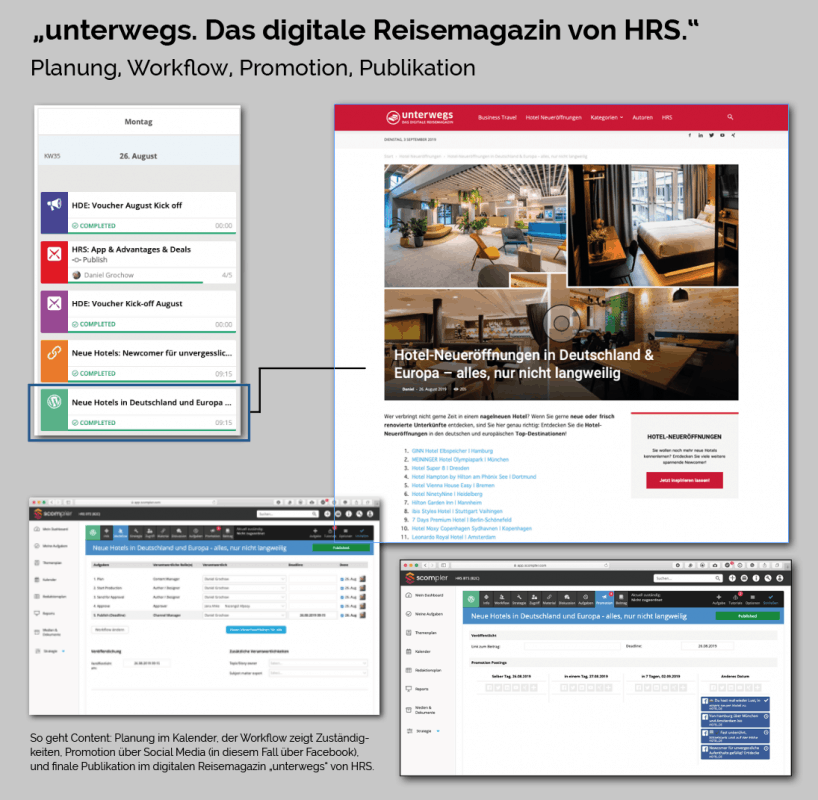
Return on Investment: Das hat uns die Arbeit mit Scompler gebracht
„Eine wichtige Fragestellung war bei uns, wie viel Arbeitszeit uns ein Tool erspart. Es war eine einfache Gegenüberstellung der Ressourcen und der Produktionszeiten.
Rein von den Ressourcen sind wir bei ca. 20% Zeitersparnis im Gesamtprozess, von der Idee bis zur Publikation einer Story, seitdem wir den Content-Prozess umfänglich eingeführt haben. Die durch effiziente Abstimmungsprozesse freigewordenen Kapazitäten können wiederum zielgenau eingesetzt werden. In Hinsicht auf Time-to-Market bedeutet dies auch: Wir arbeiten in einer anderen Geschwindigkeit, können schnell reagieren und setzen unsere Kommunikation schneller um.
Es ist ein Erfolgsrezept, Business-Ziele und Kundenbedürfnisse zusammenzubringen und daraus die Kommunikation zu entwickeln. Es ist alternativlos, sich zusammenzusetzen und kanalübergreifend in die Zukunft zu blicken – weil wir nicht wissen, was in fünf Jahren für Kanäle da sind, weil es einfach effizienter ist und weil auch die Leute, die man erreichen will, zunehmend davon genervt sind, wenn man es nicht tut.“
Juliane Howitz, HRS

